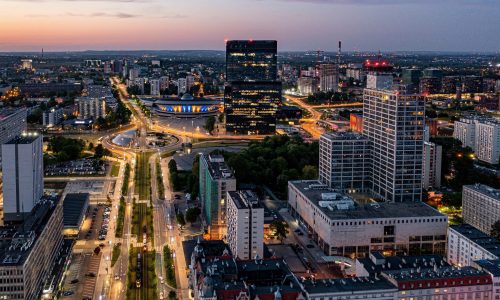The development of Intelligent Transport Systems (ITS) is an answer to the growing traffic challenges facing modern cities. In Katowice, as in many other metropolitan areas, heavy vehicle traffic caused congestion, increased travel times and increased the risk of accidents. In response to these problems, the city decided to implement an advanced ITS that would optimize traffic flow and increase road user safety through the use of modern information and communication technologies.
Key components and functionalities
Katowice’s intelligent traffic control system is based on several key components, including a network of traffic sensors, surveillance cameras, dynamic message signs, and advanced analysis software. It enables continuous analysis of the traffic situation, prediction of congestion, and dynamic modification of traffic signal settings to optimize vehicle flow. In addition, ITS supports traffic management during emergencies, for example by automatically rerouting traffic in the event of accidents or breakdowns.
One of the system’s most innovative features is its ability to prioritize public transit vehicles and emergency services. This allows buses and trams to move through the city with less delay, an important step in promoting public transportation as an effective alternative to single-occupancy vehicles. In turn, faster response by emergency services has a direct impact on improving the safety and health of residents.
Benefits and challenges
The system is an important tool in the implementation of the city’s sustainable development policy, promoting the use of public transport and bicycles, thereby contributing to reducing the negative impact of transport on the environment.
The implementation of ITS in Katowice brings a number of benefits. It optimizes travel time and emissions by improving traffic flow and enhancing road safety. ITS enables integration with other systems, such as mobile applications to manage public transport or systems to support car-sharing and urban cycling, changing the way residents move around the city.
The vision of a “smart city,” where all elements of a city’s infrastructure are connected and communicate with each other to optimize life, is becoming a reality. The challenge is to provide solutions that are accessible and affordable to all segments of society and to raise awareness of the benefits of new technologies. This will bring tangible benefits to the city, allow the full potential of intelligent traffic management to be realized, and contribute to building a sustainable, safe, and friendly urban environment.
Summary
The intelligent traffic control system in Katowice is an example of how modern technologies can influence the development of cities, making them more functional, safer, and environmentally friendly. The project proves that the responsible and thoughtful use of information innovations in the management of urban infrastructure can significantly improve the quality of life of residents and serve as a model for other cities striving for sustainable development. The success of such initiatives depends on a number of factors, including the commitment of the authorities, the openness of the public to change, and the constant effort to improve and adapt the system to the dynamically changing conditions and needs of residents.





